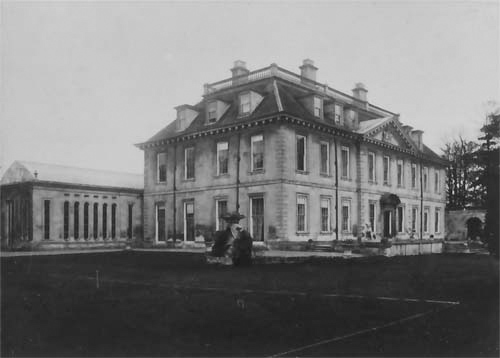Uffington House
Lincolnshire
| Location | Uffington | ||
| Year demolished | 1904 | ||
| Reason | Fire | ||
| See all images: | Gallery | ||
| << Back to the main list |
Fire has long posed one of the greatest threats to the survival of the English country house. Its destructiveness extends beyond architecture, consuming interiors, collections, and archives, and severing the historical and familial ties that bind a house to its landscape. The indiscriminate nature of fire has meant that some of the nation’s most distinguished houses have been lost. In Lincolnshire, few were as architecturally significant as Uffington House, a building that once stood in comparison with the finest in the county, including the celebrated Belton House.
 Uffington House was notable as one of the earlier post-Restoration country houses to exhibit the growing influence of classical architecture. The period of the Commonwealth (1649-1660) had been largely dormant in terms of country house construction. Political instability, combined with the redistribution of wealth and land, left few individuals willing or able to embark on major building projects. However, the Restoration of the monarchy in 1660 brought renewed confidence and patronage. The court of Charles II encouraged a revival in architectural ambition, with newly created titles and recovered fortunes often finding expression in the construction of country seats.
Uffington House was notable as one of the earlier post-Restoration country houses to exhibit the growing influence of classical architecture. The period of the Commonwealth (1649-1660) had been largely dormant in terms of country house construction. Political instability, combined with the redistribution of wealth and land, left few individuals willing or able to embark on major building projects. However, the Restoration of the monarchy in 1660 brought renewed confidence and patronage. The court of Charles II encouraged a revival in architectural ambition, with newly created titles and recovered fortunes often finding expression in the construction of country seats.
This architectural resurgence was accompanied by the reintroduction of classical forms, informed both by the earlier work of Inigo Jones and by more recent Continental influences. Although Sir Christopher Wren’s involvement in country house design was limited, he remains emblematic of the broader shift towards Baroque classicism in the later seventeenth century. One of the few houses attributed to Wren is Tring Park (formerly Tring Manor House) in Hertfordshire, built between 1669 and 1671. Its innovative design - nine bays wide and two storeys tall with a central pediment - helped establish a template that would influence subsequent developments.
By the late 1670s, this architectural language had spread beyond London and the Home Counties. In Northamptonshire, Walcot Hall (c.1678) adopted a similarly composed façade, demonstrating the adaptability of the new classical idiom. Uffington House, designed shortly thereafter, owes much to this emerging style.
The Uffington estate was acquired for Charles Bertie, fifth son of Montagu Bertie, 2nd Earl of Lindsey. The design of the house, prepared in 1675, is attributed to a little-known figure referred to in the account books only as ‘Mr Grant, Surveyor’. He was paid £4 2s. 6d. ‘...for making a plan of Uffington House and surveying several parcels of land adjoining to it.’ Construction began in 1681 and was substantially complete by 1686–1688. In August 1687, Bertie wrote:
'The house which I am now building "in the afternoon of my age" you must not call a fine house: but I hope it will be big enough for a younger brother's family'
Despite Bertie’s modesty, the house was among the most refined in Lincolnshire. The interiors were richly decorated, with walls and ceilings of the principal staircase painted by Antonio Verrio. A favoured artist of Charles II, Verrio had worked at Windsor Castle and later spent over a decade at nearby Burghley House, where he executed the celebrated ‘Heaven Room’. His contribution to Uffington added to the house’s status as an artistic as well as architectural landmark.
In time, the title of Earl of Lindsey passed to the Berties of Uffington. The house remained in the family until disaster struck on 18 December 1904, when a fire destroyed the main building, leaving little more than rubble. Some ancillary structures, including the orangery, ballroom, and service ranges dating from 1845, initially survived. The orangery, designed by Samuel Gray, was of particular interest, though little else is recorded of his architectural career. In 1979, permission was granted for the demolition of these remaining buildings, with their materials repurposed to repair boundary walls on the estate. This work, completed in 1980, removed the last physical traces of a once significant country house.